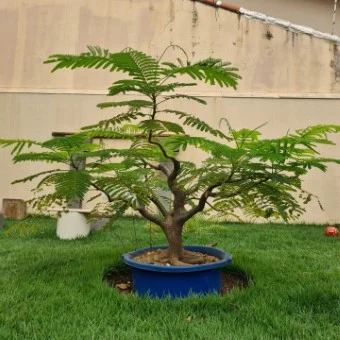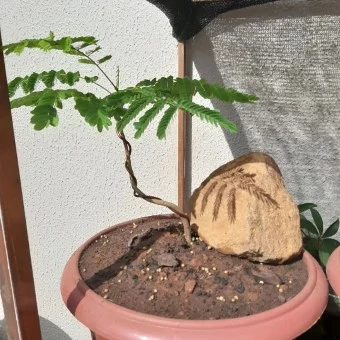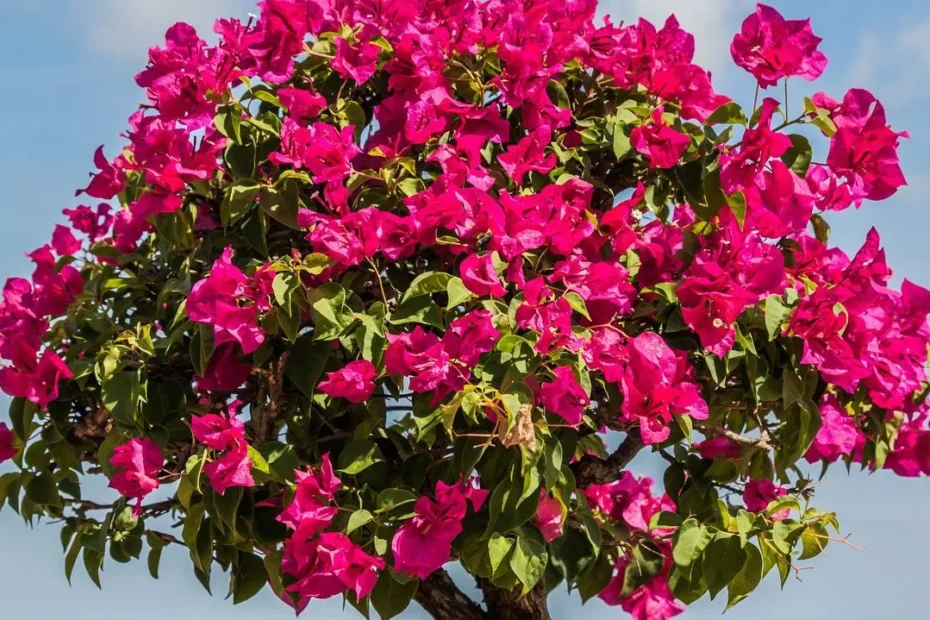Introduction
Did you know that the flame tree, also known as Delonix regia, when cultivated as a bonsai, can bloom with its spectacular fiery red flowers even indoors? This magnificent display of nature’s artistry has fascinated horticulturists and bonsai enthusiasts for centuries, making it a prized specimen in collections worldwide.
My name is Anitha, and I’ve been passionately cultivating bonsai trees for over a decade. Among the many species I’ve worked with, the flame tree bonsai has always captured my heart with its vibrant colors and the challenge it presents in mimicking its natural tropical glory in miniature form. This comprehensive guide is designed to share my experiences and knowledge, helping you nurture a thriving flame tree bonsai that blooms with all the fiery beauty of its full-sized counterpart.
Understanding the Flame Tree Bonsai
Botanical Background
The flame tree, scientifically known as Delonix regia, belongs to the family Fabaceae. It is renowned for its rapid growth and its capacity to produce a spectacular display of vibrant, fiery red flowers. Originating from the Madagascar region, this species thrives in a tropical to sub-tropical climate, exhibiting a broad and extensively branching canopy in its natural habitat.
When cultivated as a bonsai, it retains its awe-inspiring attributes on a miniature scale, blooming with the same intensity of color and beauty. One of the most captivating aspects of the flame tree bonsai is its ability to bloom within the confines of a pot, providing a unique challenge to enthusiasts to maintain its natural tropical essence in a reduced form.
Benefits of Owning a Flame Bonsai
Owning a flame tree bonsai comes with a plethora of unique benefits. Its unmatched visual appeal, characterized by verdant foliage and brilliant red blooms, makes it an extraordinary centerpiece in any collection, offering aesthetic pleasure throughout the year. Furthermore, it serves as an exceptional conversation starter, drawing attention and sparking interest among guests.
More deeply, the flame bonsai symbolizes passion, invoking a sense of warmth and vibrancy in its surroundings. It represents an enduring commitment to beauty and the meticulous care that symbolizes the bonsai cultivation practice.
Challenges and Considerations
While the flame tree bonsai offers unparalleled beauty, it also presents certain challenges. Its susceptibility to frost requires protectiveness in colder climates, necessitating a controlled environment during the winter months. Additionally, achieving the perfect balance of sunlight, watering, and feeding to mimic its natural tropical conditions can be demanding.
However, with over a decade of experience in cultivating bonsai trees, including the delicate flame tree, I have developed and refined methodologies that effectively address these challenges. Through this guide, I aim to share insights and practices that will empower you to overcome these difficulties, enabling your flame bonsai to flourish and display its full, magnificent potential.
Cultivating Your Flame Tree Bonsai
Choosing the Right Bonsai: Seed-Grown vs Pre-Bonsai
When venturing into the cultivation of a flame tree bonsai, one of the initial decisions you’ll face is whether to start from seeds or to acquire a pre-bonsai specimen. Seed-grown bonsais offer a profound sense of accomplishment, as you witness the entire lifecycle from a mere seed to a blooming masterpiece. This path grants unparalleled control over shaping the bonsai from its earliest stages but requires substantial time investment—often years—before you see the fruits of your labor.
Conversely, pre-bonsai trees are juvenile plants that have already undergone some preliminary shaping and growth. They offer a head start, allowing enthusiasts to enjoy the shaping and training process much sooner. When selecting a pre-bonsai, pay close attention to the pot size and root development, as these factors will significantly influence your bonsai’s future growth and shape.
Location and Light
The flame tree bonsai thrives under full sun and warm conditions, mirroring its natural tropical habitat. Indoors, positioning your bonsai near a south-facing window can help simulate these conditions, ensuring your plant receives ample light throughout the day. During winter or in less sunny climates, consider using grow lights to create a suitable microclimate. These lights compensate for the lack of natural sunlight, helping your bonsai maintain its vibrant growth and flowering capacity year-round.


Watering Techniques
Proper hydration is critical to the health of your flame tree bonsai. A balanced approach entails deep soaking the soil, then allowing the top layer to dry out before the next watering. This method ensures the roots are sufficiently moisturized without remaining waterlogged, which can lead to root rot. Signs of under-watering include wilting and dry, brittle leaves, while overwatered bonsais may exhibit yellowing leaves and a general lack of vigor. Monitoring your bonsai closely will help you establish a watering routine that accommodates seasonal variations in water needs.
Soil Selection
Choosing the right soil mix is pivotal for the health and growth of your flame tree bonsai. A well-draining mixture, consisting of components like akadama, pumice, and lava rock, facilitates proper moisture retention and air flow to the roots. This combination not only supports robust growth but also aids in preventing soil compaction over time. The ideal mix provides a balance, ensuring that water does not drain too quickly, which could lead to dehydration, nor does it accumulate at the roots, posing a risk of rot.
By meticulously selecting your bonsai based on its growth stage, ensuring it receives adequate light and warmth, mastering the art of watering, and choosing an optimal soil mix, you can set the foundation for a healthy, thriving flame tree bonsai. The effort and understanding invested into these early stages will pave the way for a rewarding bonsai cultivation experience.
Maintaining Your Flame Tree Bonsai
Fertilizing Your Flame Bonsai
Fertilizing is vital for the health and blooming capabilities of your flame tree bonsai. During the growing season, typically from spring to late summer, fertilize every two weeks with a balanced NPK (Nitrogen, Phosphorus, Potassium) ratio of 10-10-10.
This provides a steady supply of essential nutrients. In the dormant season, reduce fertilizing frequency to once a month and consider a fertilizer with a lower nitrogen content to encourage root development and prepare the tree for the next growing season.
Pruning and Wiring
Pruning is crucial for maintaining the desired shape and size of your bonsai, as well as promoting healthy growth. Utilize sharp, clean tools to make precise cuts just above leaf nodes or branches, and apply a sealing compound to larger cuts to promote healing and prevent diseases.
Wiring can be employed to shape branches, but it’s essential to monitor the tree’s growth closely to prevent the wire from cutting into the expanding bark. Beginners seeking to wire their bonsai should refer to resources specifically tailored for novices, offering step-by-step instructions and visual guides.
Repotting Considerations
Repotting is a key aspect of bonsai care that impacts the health and growth of your flame tree. It should typically be done every 2-3 years, but younger, faster-growing trees may require more frequent repotting. The ideal time for repotting is early spring, just before the growth season begins.
When repotting, carefully prune the roots to encourage new growth; however, avoid cutting more than one-third of the root mass to prevent stressing the tree. Choose a pot that complements the size and style of your bonsai, ensuring it has adequate drainage to prevent waterlogging.
By adhering to these guidelines on fertilizing, pruning, wiring, and repotting, you ensure that your flame tree bonsai remains healthy, vibrant, and beautifully shaped for years to come.
Flame Tree Bonsai Troubleshooting Common Issues
Despite meticulous care, your flame tree bonsai may encounter common problems that can affect its health and appearance. Understanding these issues and their solutions is key to maintaining a thriving bonsai.
Yellowing Leaves
Yellowing leaves can signal a nutrient deficiency or overwatering. If nutrient deficiency is suspected, ensure you’re using a balanced fertilizer with an appropriate NPK ratio. In cases of overwatering, allow the soil to dry slightly between watering sessions and ensure your pot has adequate drainage to prevent waterlogged soil. Adjusting your watering routine can often resolve this issue.
Lack of Flowers
A flame tree bonsai’s failure to produce flowers can often be attributed to insufficient light or incorrect fertilization. Ensuring your bonsai receives full sunlight for most of the day is crucial for flower production. If you’re growing your bonsai indoors, placing it near a south-facing window or supplementing with grow lights can help. Adjusting your fertilization to a phosphorus-rich formula during the growing season can also encourage blooming.
Pest and Disease Control
Pests and diseases can significantly affect the health of your bonsai. Organic methods, such as neem oil or insecticidal soap, are effective for treating many common pests and fungal infections while being safer for the environment than chemical treatments. Regular inspection of your bonsai for signs of distress, such as discolored or damaged foliage, can help catch issues early before they become severe.
When to Seek Professional Help
While many common issues can be resolved with the adjustments mentioned above, some problems may require expert intervention. If your bonsai exhibits severe symptoms, such as extensive leaf drop, large-scale yellowing, or persistent pest infestations despite treatment, it’s advisable to consult a bonsai expert. Professionals can offer tailored advice and treatments, ensuring your bonsai receives the best care possible. Remember, the key to successful bonsai care is patience and attentiveness, allowing you to enjoy the beauty of your flame tree bonsai for years to come.
Conclusion
Cultivating a flame tree bonsai is a profoundly rewarding experience, combining the artistry of shaping with the science of plant care. This practice not only beautifies your space but also nurtures patience, diligence, and a deep connection with nature. For those eager to deepen their knowledge, books such as The Bonsai Beginner’s Bible by Peter Chan, and online communities like the Bonsai Empire forums, offer invaluable insights and support.
We encourage you to share the milestones and challenges of your flame bonsai journey in the comments below. Your experiences and questions enrich our growing community, fostering a shared love for the art of bonsai.
